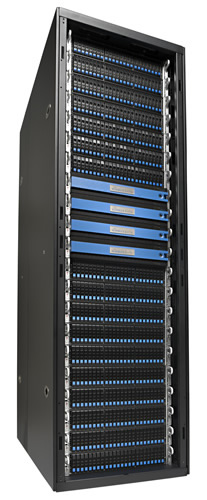Storage maker Nimbus Data Systems has launched its newest product line, the E-Class Flash Memory System, which scales up to 500 terabytes per file system and is equipped with enterprise goodies like fault tolerance and high availability. The latest offering is designed to provide a faster, denser, and more energy-efficient alternative to high capacity disk-based systems and is being aimed at cloud infrastructure, mission critical enterprise applications, and high performance computing.
 The E-Class builds on the success Nimbus has enjoyed with its mid-range S-Class flash storage offerings, which has propelled the company to three consecutive years of profitability. In 2011, with the help of some big wins at companies like eBay, the Nimbus collected five times the revenue it did in 2010.
The E-Class builds on the success Nimbus has enjoyed with its mid-range S-Class flash storage offerings, which has propelled the company to three consecutive years of profitability. In 2011, with the help of some big wins at companies like eBay, the Nimbus collected five times the revenue it did in 2010.
The company’s strategy is based on a rather simple premise: offer flash storage at the same price point as the 15K SAS disk-based systems it intends to displace. By using enterprise MLC (eMLC), a NAND technology offers a sweet spot between the low-priced, consumer-grade MLC and the higher performance SLC NAND, Nimbus is able to build solid state storage systems in the $10/GB neighborhood. That puts the cost of Nimbus’ gear on par with high performance 15K SAS disk systems (although not the cheaper bulk SATA drives), while offering the superior performance, density, and energy-efficiency inherent in solid state storage.
Unlike some flash storage vendors like Fusion-io, who have built their business around PCIe connected solid state memory, Nimbus offers only externally connected flash-based systems. According Nimbus CEO and founder Thomas Isakovich, while PCIe flash solutions are fast, they are not scalable since they are captive to the server they inhabit. By offering the more traditional storage architecture, they’ve been able to go after users who are looking to replace or augment existing storage gear.
A growing client list attests to Nimbus’ success. Besides eBay, the company has sold S-Class systems to a number of other elite customers, who, at this point, have chosen to remain nameless. Isakovich says these customers include top providers in virtualization software, news/digital information, freight management, electrical power, and post-production technology. In the high performance computing realm, Nimbus has deployed systems at a “top 3” supercomputer center, a US DoD agency, a financial services firm that does portfolio optimization, and in three of the largest semiconductor companies.
Nimbus’ entrance into high performance computing was made all the more easy by the addition of InfiniBand connectivity to its S-Class storage last year. Although Ethernet connectivity is still fairly common in HPC storage setups, many users prefer to use InfiniBand for both the cluster interconnect and their storage infrastructure. “We’re finding our InfiniBand capability is getting more and more attention,” says Isakovich.
While the S-Class products were theoretically able were able to scale up to 250 TB per system, they lacked the redundancy and fault tolerance that would have made deployments at that capacity practical. Instead, customers like eBay who wanted a 100 TB or more of flash deployed a number of smaller storage systems and automated their management.
That’s where the new E-Class product fills the gap. These systems offer capacities up to 500 TB that can be managed under a single file system. Thanks to dual controllers in each enclosure, there are redundant paths to all storage. That enables software updates and automated failover to be performed without shutting down the system. Similarly, additional capacity can be added and individual flash modules can be swapped while the system is up and running.
The extra robustness enables E-Class systems to be expanded into the hundreds of terabytes range. According to Isakovich, this makes this latest product line the most scalable flash storage offering in the world, offering about 20 times the capacity of their closest competitor. “For the first time, people will be able to deploy large amount of capacity on flash, instead of using it for small-capacity tiering or caching,” he says.
The E-Class inherits all the capabilities of the mid-range S-Class, including RAID redundancy, spares, unified SAN and NAS support in a single system, the built-in HALO storage OS, and perhaps most significantly the $10/GB price. And although it uses the same NAND chips as the S-Class, Nimbus was able to package them more densely in the new E-Class
Specifically, the E-Class boxes hold 10 TB per rack unit, which is twice the density of the S-Class arrays and three times that of 15K disk storage. From an IOPS perspective, the advantages over disks are even more impressive, with an E-Class system delivering 14 times the I/O bandwidth as a comparably sized disk setup . And because its solid state, the Nimbus gear draws 80 percent less power than its spinning disk competition: 5 watts/TB versus 25 watts/TB, respectively.
Some of those disparities could widen even further. Nimbus is currently using 34nm NAND chips, but when sub-30nm eMLC flash silicon becomes available, storage densities will increase once again. Isakovich also thinks they will be able to package those chips into even tighter designs. Within 18 months, he says, they could have solid state systems on the order of 10 times the density of 15K-based systems. According to Isakovich, what they are offering today is “just the tip of the iceberg.”
Related articles
Nimbus Revs Up Flash Storage Offering
Nimbus Goes After HPC Market with Disk-Priced Flash Array



























































